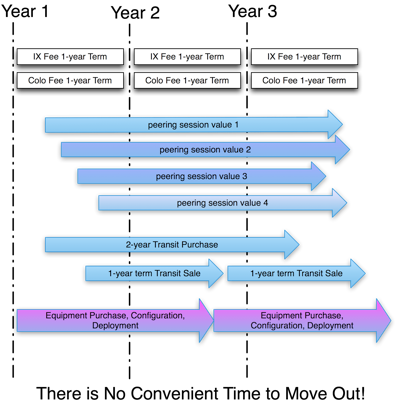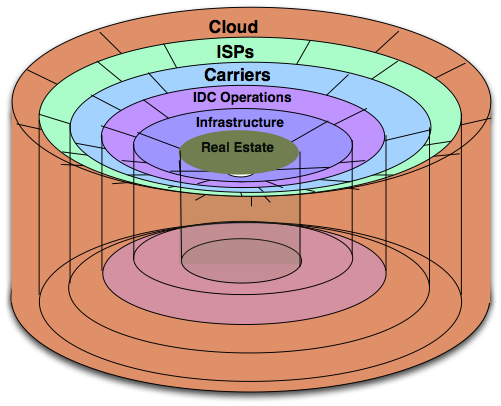Ask Dr. Peering




Q:
DrPeering –
I don’t like my colocation provider. They
-
-charge too much,
-
-make it difficult and time consuming to cross connect,
-
-don’t seem to test their cross connects,
-
-don’t return phone calls in a timely manner,
-
-don’t keep us informed inform about outages,
-
-send us indecipherable bills,
-
-don’t return calls to order additional services,
-
-and yelled at my dog Reggie.
The only thing they do proactively with their services is raise prices on them.
I would leave but they are the best colocation provider in the area.
What forces will cause more responsive colocation competitors to enter this colocation market?
Joel Backman
A:
Joel -
It sounds like a sticky situation. There are three factors that keep companies (sticky) as customers of colocation providers:
Value-Based stickiness is where the value derived from participation exceeds the cost (and pain) of participation as shown in the figure below.

It sounds like your colocation provider believes that they provide so much value that their customers will endure a little more pain and cost.
Time-Based Stickiness is where networks stay at a colocation company because there is no convenient time to leave because their contracts (transit sales, transport, customer, colo, peer, etc.) never align at a single convenient termination time.

Interdependence-based Stickiness is where networks stay because of who they need to interact with those who are there.
Advice
It’s time for you to take a hard look at the value that you derive from this colocation provider and the nature of the stickiness that keeps you and your peers there..
Who else is there that is important to you? Are they also located somewhere else? Might you be able to persuade them to leave with you to a competitor colo? Is there enough pain to start a rebellion and convince others to move out as well? When two providers are in a market it is common for networks to play one off against the other to obtain concessions.
Encourage the alternative
I bet there are alternative colocation and peering companies that would love to speak with you, Mr. disgruntled customer, especially if you can persuade others to move out into their facilities. You will get a good price but you should be prepared to articulate a win-win strategy to help the upstart colo/peering point buy into some short-term loss for a sustainable long-term position.
A good IXP will lead. They will facilitate and speed peering among its population, will embrace networks that help them get to critical mass, will be a leader in the peering community, will spur innovation and help build upon aligned interests. In short, they should be seeking you out.
Find your enemy’s enemies and build alliances.
Q:
DrPeering –
I’m new to the peering game and want to meet peers, but I don’t know anyone...yet. What apps should I buy?
Ronald Keith Williamson
A:
Ron - Your innocence is charming, but there is no app for peering....yet.
Your question reminds me of my favorite unsolved challenge: The Cocktail Hour Problem.
The Cocktail Hour Problem
How does an Internet Exchange Point (IXP) operator maximize the effectiveness of a gathering of peering coordinators?
That is, construct a social context whereby every person in the room walks away from the event receiving as much value as possible given who else is in the room.
In the more general case, the cocktail hour problem is trying to identify those strange pieces of information that we all have in our heads, and identify (perhaps unexpressed) interests of those in the group, and finding an efficient way of matching these up at a cocktail hour.
In the case of a peering cocktail hour, we might simplify the problem to engineer a social context whereby all peering discussions that could provide value is accomplished at the meeting. Everyone leaves believing that the cocktail hour was a great success for them, provides demonstrable value, and everyone looks forward to the next one.
We have seen a number of good attempts at Peering Forums and IXP member meetings around the world:
-
1)Peering Personals is where folks step up to the front of the room, introduce themselves, their AS Number and why you should want to peer with them.
-
2)Peering meeting makers allow you to select specific discussions and schedule them at specific tables at specific times. You need to know in advance who might be interesting to speak with, but the conversations are direct and have the benefit of being uninterrupted.
-
3)Ad hoc social events provide the context for unplanned informal discussions that allow one to build a database of peering intel, and perhaps a few peering sessions or transit deals at the same time.
-
4)Peering Cruises have become less popular because they don’t pass the sniff test of most travel auditors, but they provide an extended interaction model where virtually everyone lets their guard down. At the end, friendships are made and maintained, and a stronger community results.
-
5)Repeated exposure is a tried and true solution where the peering coordinator attends every peering event possible. Over time, trust is built up, and the peering person is inculcated into the group.
One mistake that networks make is sending different people to peering events, alternating for internal “fairness.” Unfortunately, from the peering community perspective, this tactic means that no one person is seen as a ‘regular’ in the peering community. No single person establishes a foothold, establishes a reputation or rapport with others in the group. This strategy has failed every time.
Anyway, none of these five social engineering approaches to the cocktail hour problem are optimal, and there may be an app coming that can help speed things along. Until then, the old fashioned, “get engineers a few beers” has always been helpful at greasing the skids towards peering. More parties may be the answer. More work before the cocktail hour may be the answer. In any case, I look forward to hearing about more innovative solutions to the cocktail hour problem.
Q:
DrPeering –
How does cloud benefit from peering?
Clay Carter
A:
Clay -
I see cloud computing as expertly leveraging Internet bandwidth, secondary storage and compute power on demand with an effective GUI dashboard. All of these cloud services require a stable data center foundation with plenty of power and the ability to scale bandwidth requirements across a multitude of service providers as shown in the figure below.

Flexible multi-vendor network bandwidth is the colocation provider strong suit, particularly network neutral facilities. Once in a network dense colocation facility, cloud providers are free to peer with and/or purchase transit from any network provider. If you squint, a cloud provider is a very large scale hosting provider, CDN or a Large-Scale Network-Savvy Content Provider that could peer a lot of their client content away for free while there. All of the benefits of peering apply to cloud providers and their clients.
Arnold Nipper comments:
“I see a huge difference between cloud and content providers. Whereas content providers tend to be as close to the user as possible this does imho not hold for a could provider. A cloud provider - at least thebigger ones - will try to build _massive_ datacenteres to gain
efficiency. For resilience reasons they will have multivendor upstreams.But I can not yet see that cloud providers are as peering hungry ascontent providers are.”
Agreed. But to the peering world, cloud providers look like content providers. Since the days of peering stone knives and bearskins, content providers have had less peering negotiating power than access providers. And now, access networks are more inclined to demand metered payment for delivering content bits. Therefore, these guys will require some seasoned peering coordinators to build their peering justification and interconnect models with the access networks.
If cloud providers are smart and bring on the peering talent that they need, the cloud providers could leverage peering to a significant degree. And, large scale network neutral colocation providers are the best place to do this.
Keep-on-Peering -

Peering for cloud?
How does one displace an entrenched colocation provider? How does one enter the Peering Community?
Peering for Cloud Providers
January 29, 2013

The 2014 Internet Peering Playbook
In Print
and for the Kindle:
The PDF, ePub and
.mobi files are
also available as a
perpetually updated
DropBox share:
Price: $9.99
and in French!
The 2013 Internet Peering Playbook
also available for the Kindle:
and the ipad






